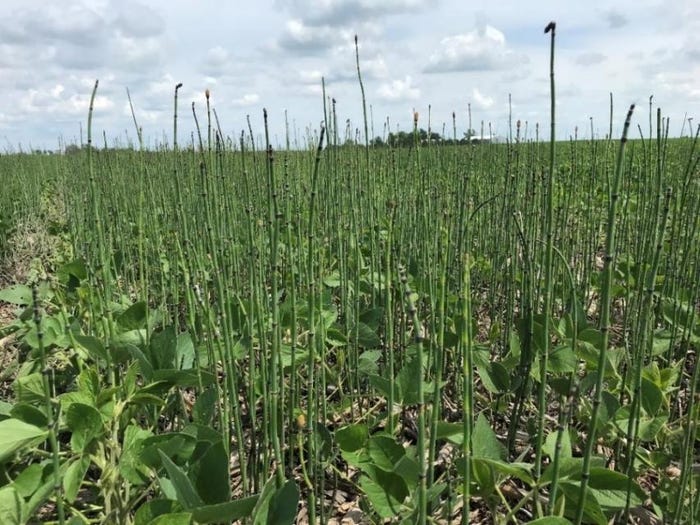May 23, 2022

Scouringrush (Equisetum arvense) and field horsetail (Equisetum hymale) are two species of the Equisetum genus found in Iowa. There are 15 Equisetum species worldwide. They are primitive perennials that produce spores rather than seeds and spread primarily by rhizomes (underground stems). These two weeds are commonly found in roadside ditches, preferring poorly drained soils.


While individual shoots of scouringrush and field horsetail are not highly competitive, dense colonies can interfere with crop production. Tillage can suppress the weeds, but it probably would take several years of intensive tillage to eradicate them from fields. Unfortunately, tillage can break rhizomes of both species into small pieces and spread them throughout the field.
The architecture of the equisetum’s canopies reduces the area for herbicide absorption, making them particularly difficult to manage with herbicides. Herbicides used in crop production do not provide significant control/suppression of equisetums.
Most infestations of these weeds are due to a source population in adjacent non-crop areas. Controlling the equisetum in these areas probably is the most efficient method of removing them from crop fields, but unfortunately this is not an easy task, either. Repeated mowing or tillage is one option, but again it will take several years of disturbance to control/eradicate the weed.
Chlorsuluron (Telar) is one herbicide that has good activity on equisetums, but is only registered for use in non-crop sites such as roadsides. Chlorsulfuron is a sulfonylurea herbicide (Group 2), related to products such as Accent and Classic. Multiple applications would be needed for complete control. UNL researchers conducted a study near Murdock, Nebraska with several herbicides and reported chlorsulfuron provided the most effective control of scouringrush. However, chlorsulfuron is a persistent compound that is toxic to both corn and soybeans, so caution must be taken to prevent overspray into production fields.
Chlorsulfuron is recommended at 1.0 to 2.6 oz/A (75% dry formulation) for controlling equisetums. Spot applications at higher rates are allowed in certain locations according to the product label. An 8 oz. container is the smallest quantity that could be found on the internet. This container would provide sufficient herbicide to treat approximately a mile of a 20 ft. roadside twice at the intermediate rate.
Purdue University researchers evaluated the efficacy of spring or fall applications of several other herbicides on mowed and unmowed scouringrush. When mowing, it was necessary to allow some regrowth of new plant stems prior to herbicide application, to produce desirable control with herbicides. Unmowed scouringrush did not produce acceptable results.
Researchers reported that mowed scouringrush treated in the fall with aminopyralid (Milestone) and imazapyr (Habitat) may provide additional effective options in non-crop areas for controlling scouringrush populations. In unmowed populations, biomass of scouringrush was not reduced at 42 days after application. Aminopyralid and imazapyr are not labeled for row crops and have a lengthy rotation restriction.
Regardless of the management tactic chosen, persistent effort is important to eliminate equisetum populations. Focusing efforts outside of crop fields on the adjacent source area in addition to suppression in the crop field is likely to yield the best results.
Source: Iowa State University, which is solely responsible for the information provided and is wholly owned by the source. Informa Business Media and all its subsidiaries are not responsible for any of the content contained in this information asset.
You May Also Like




